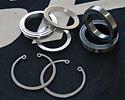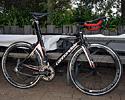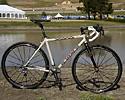
 |
 |
 |
 |
 |
 |
 |
 |
 |
 |
On Show: Sea Otter Classic, April 22, 2008
The end of the threaded bottom bracket?
By James Huang
BB30 makes major inroads for 2009
|
|
|
Cannondale was accused of needlessly stirring the industry pot when it introduced its BB30 integrated bottom bracket standard years ago. However, much like Manitou and its 74mm post mount brake tabs, Cannondale can now proudly say 'I told you so' as the now-open BB30 bottom bracket and crank standard will be far more widely adopted for 2009.
From a strictly engineering standpoint, BB30 is an easy sell: all other things being equal, it's lighter and stiffer than current external-type bottom bracket systems while also offering reduced pedal stance widths and longer bearing lives thanks to the narrower, but larger diameter, bottom bracket shell.
FSA readily admits that the most dramatic weight savings probably won't come at the high end, though: by its own calculations, the BB30 version of its SL-K Light crankset sheds just 24g. Thankfully, the biggest benefits will likely be found at the mid-range. For example, FSA's standard Gossamer crankset weighs 936g complete but the BB30 version is just 830g.
The new standard will obviously create some compatibility headaches moving forward but a number of companies apparently feel the advantages are too great to ignore. At a BB30 presentation during this year's Sea Otter Classic, manufacturers such as Cannondale, Kona, Jamis, Titus and Caribou all showed off BB30-compatible bicycles while event host FSA displayed no fewer than seven corresponding cranksets covering a wide range of uses. Specialized frames equipped with its house brand integrated cranks are also apparently BB30-compatible even though the company doesn't tout them as such.
Even with this impending wave, though, some of the growing pains may be ameliorated by the fact that any BB30 shell can be fitted with an adapter to allow the use of standard threaded bottom brackets.
Cannondale Rize and Moto models highlight effectiveness of systems integration
|
|
|
Cannondale, the originator of the BB30 standard, showed off its new Rize trail bike platform that highlighted the effectiveness of its integrated approach to bicycle design. The Rize is claimed to weigh as little as 10.7kg (23.5lb), roughly the same as many high-end full-suspension race bikes, but offers 130mm of travel at either end while supposedly still delivering top-end bump performance and chassis rigidity.
Much of the credit for the feathery weight of the top-end Rize 1 assuredly belongs to the carbon-and-aluminum frame and premium spec but a pair of proprietary parts also lends helping hands. For example, the new Lefty Max Carbon PBR fork is among the stiffest front suspension platforms we've laid hands on (two legs or one) yet is said to weigh just 1.3kg (2.9lb), thanks in part to the integrated stem and steerer tube. Likewise, the BB30-standard Hollowgram crank continues the 'light but stiff' theme with its directly pressed-in bearings and 30mm-diameter aluminum spindle.
In Cannondale's case, the integrated approach is anything but new but the company has proven that sticking to its once-unorthodox design principles works well.
While not necessarily rife with integrated systems, Cannondale's new Moto looks to be an impressive bit of kit nonetheless as it offers 160mm of travel front and rear in a no-compromise package claimed to weigh under 13.6kg (30.0lb). The top-end Moto 1's shock linkage is cleverly designed such that its carbon front triangle is always under tensile, rather than compressive, load and the stout single pivot rear end is bridged at no fewer than four locations for good torsional rigidity.
Titus explores the BB30 possibilities
|
|
|
|
|
Arizona-based builder Titus showed off its own BB30-equipped hardtail and it was quite the stunner. The unnamed prototype was essentially an off-road version of its Ligero road machine, complete with an Isogrid co-molded carbon fiber-and-titanium top tube and down tube as well as an integrated seat mast capped with a Ritchey head. Convertible rear dropouts also allow for either geared or singlespeed use. Claimed frame weight is just 1.54kg (3.4lb) with an uncut mast.
Why bother with such an extravagant hardtail, though, when full-suspension seems like the default choice these days, you ask? According to PR man Jeff Titone, Titus' own hardtail sales have soared 50 percent last year as more and more riders re-embrace the performance appeal of their lighter weight and increased responsiveness. If the new frame also delivers on its promise of offering similar ride characteristics to the Ligero, easily one of the sweetest riding road frames we've handled in recent memory, sign us up.
Titone said the new frame was still in the experimental phase for now as it still had to undergo testing. Assuming everything goes well in that department, it's entirely possible that we'll see it in the 2009 lineup along with a BB30 option for other models. Projected cost on the prototype hardtail hasn't been set yet, but Titone said it'd likely be 'no less than US$3500". Better start saving now.
Photography
For a thumbnail gallery of these images, click here
Images by James Huang/Cyclingnews.com
- It may be sooner rather than later that the BB30 standard replaces the threaded shells we're used to seeing.
- The bottom bracket itself is remarkably simple ; in FSA's case, it comprises just a pair of bearing, a pair of snap rings and a few spacers.
- Cannondale was the first to develop and use BB30 but it can now be viewed as an industry pioneer rather than an technical outlier.
- Among the BB30 adopters is Jamis who showed off a BB30-equipped sample of its Xenith SL road frame.
- The BB30 shell is larger in diameter and easier to make, but bore tolerances will still need to be pretty tightly controlled for good bearing life.
- The BB30 shell is also just 68mm wide and since the bearings are contained within, pedal stance widths can be brought back down.
- Kona showed off this BB30-equipped full-suspension machine.
- The larger diameter shell won't allow for the mega-broad down tubes and widely spaced chain stays of some of the newest crop of frames but it does offer plenty of surface area for welding.
- Van Dessel jumped on the bandwagon earlier this season with its updated Rivet carbon road frame and Gin and Trombones 'cross model.
- Jamis also took BB30 off-road with this version of its popular Dakota.
- FSA is 100 percent on board with BB30 and will offer seven compatible models next year.
- Mountain bike versions will incorporate a small threaded collar for bearing preload; road versions get by with a wave washer.
- FSA also displayed a BMX crankset that complied with the BB30 standard.
- BH wasn't on hand at the official BB30 presentation but this sample of its Connect road frame proved that it's playing with the idea, too.
- BH's top-end G4 was proudly hanging from a scale at Sea Otter.
- And what did it weigh, you wonder? Not much.
- The G4 is also set to get even lighter courtesy of a new seatpost clamp designed by Rotor.
- Cannondale highlighted the effectiveness of integrated system design with its new Rize trail bike.
- The overall suspension layout is roughly similar to that of the Scalpel.
- The upper shock mount is bonded to the top tube.
- Asymmetrical chain stays are joined by a substantial-looking bridge.
- The Cannondale Moto offers 160mm of travel but supposedly weighs under 13.6kg (30.0lb).
- The Moto's carbon front triangle certainly deserves much of the credit for the impressively light weight.
- The single pivot rear triangle is made of welded aluminum.
- The linkage is cleverly designed such that the carbon frame is always in tension, not compression.
- The team-issued MonaVie Cannondale Scalpel is decked out and ready to roll.
- Titus brought its Isogrid concept off-road with this sharp-looking prototype.
- The top tube and down tube are both made from titanium and carbon fiber that is internally reinforced for more strength and rigidity.
- Titus is also playing with the BB30 idea on this prototype. If all goes well in testing, expect to see BB30 as an option for the '09 model year.
- An integrated seatmast is still a questionable feature on a mountain bike, but it sure looks trick and might save a bit of weight, too.
- Convertible dropouts make for easy use in fixed or geared applications.
- The upsized head tube is fitted with an FSA internal cup-style headset.
- Titus also displayed an Exogrid-equipped TRX 'cross bike.
- This particular sample was a carbon-and-steel hybrid , although 'cross frames in titanium Exogrid and straight titanium will also be available in time for 'cross season.
- The small-diameter steel tubes make for plenty of room out back.
- There's lots of clearance here for mud to squeeze through.






